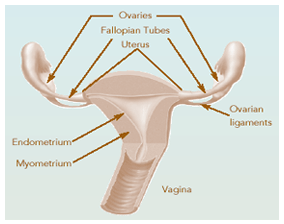The
menstrual cycle is the process by which a woman’s body gets ready for the chance of a
pregnancy each month. The average menstrual cycle is 28 days from the start of one to the start of the next, but it can range from 21 days to 35 days.
In the beginning of the menstrual cycle, levels of estrogen rise, causing the lining of the uterus to grow and get thicker. An egg starts to mature in one of the ovaries. Around the middle of the cycle, the egg leaves the ovary, a process called ovulation.
The egg begins to travel down the fallopian tubes to the uterus. If the egg becomes fertilized by a sperm cell and attaches to the uterus, the woman becomes pregnant. If not, the uterus does not need the extra thick lining and it begins to shed.
This shedding of the uterine lining through the vagina is menstruation.
